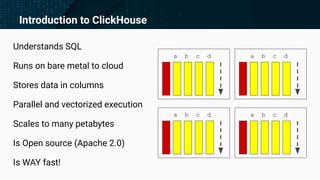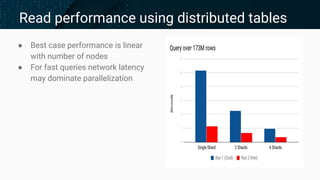Webinar: Strength in Numbers: Introduction to ClickHouse Cluster Performance
- 2. Introduction to Presenter www.altinity.com Leading software and services provider for ClickHouse Major committer and community sponsor in US and Western Europe Robert Hodges - Altinity CEO 30+ years on DBMS plus virtualization and security. ClickHouse is DBMS #20
- 3. Goals of the talk ● Introduce scaling axes of ClickHouse clusters ● Dig into distributed clusters ○ Using shards to scale writes ○ Using replicas to scale reads ● Describe handy tricks as well as common performance bottlenecks Non-Goals: ● Boost performance of single nodes (though that’s important, too) ● Teach advanced ClickHouse performance management
- 4. Introduction to ClickHouse Understands SQL Runs on bare metal to cloud Stores data in columns Parallel and vectorized execution Scales to many petabytes Is Open source (Apache 2.0) Is WAY fast! a b c d a b c d a b c d a b c d
- 6. Clickhouse nodes can scale vertically Storage CPU RAM Host
- 7. Clickhouse nodes can scale vertically Storage CPU RAM Host
- 8. Clusters introduce horizontal scaling Shards Replicas Host Host Host Host Replicas help with concurrency Shards add IOPs
- 9. Different sharding and replication patterns Shard 1 Shard 3 Shard 2 Shard 4 All Sharded Data sharded 4 ways without replication Replica 1 Replica 3 Replica 2 Replica 4 All Replicated Data replicated 4 times without sharding Shard 1 Replica 1 Shard 1 Replica 2 Shard 2 Replica 1 Shard 2 Replica 2 Sharded and Replicated Data sharded 2 ways and replicated 2 times
- 10. Clusters define sharding and replication layouts /etc/clickhouse-server/config.d/remote_servers.xml: <yandex> <remote_servers> <ShardedAndReplicated> <shard> <replica><host>10.0.0.71</host><port>9000</port></replica> <replica><host>10.0.0.72</host><port>9000</port></replica> <internal_replication>true</internal_replication> </shard> <shard> . . . </shard> </ShardedAndReplicated> </remote_servers> </yandex>
- 11. How ClickHouse uses Zookeeper INSERT Replicate ClickHouse Node 1 Table: ontime (Parts) ReplicatedMergeTree :9009 :9000 ClickHouse Node 2 Table: ontime (Parts) ReplicatedMergeTree :9009 :9000 zookeeper-1 ZNodes :2181 zookeeper-2 ZNodes :2181 zookeeper-3 ZNodes :2181
- 12. Cluster Performance in Practice
- 13. Setting up airline dataset on ClickHouse clickhouse-0 ontime _shard airports ontime clickhouse-1 ontime _shard airports ontime clickhouse-2 ontime _shard airports ontime clickhouse-3 ontime _shard airports ontime Distributed table (No data) Sharded, replicated table (Partial data) Fully replicated table (All data)
- 14. Define sharded, replicated fact table CREATE TABLE IF NOT EXISTS `ontime_shard` ON CLUSTER '{cluster}' ( `Year` UInt16, `Quarter` UInt8, ... ) Engine=ReplicatedMergeTree( '/clickhouse/{cluster}/tables/{shard}/airline_shards/ontime_shard', '{replica}') PARTITION BY toYYYYMM(FlightDate) ORDER BY (FlightDate, `Year`, `Month`, DepDel15)
- 15. Trick: Use macros to enable consistent DDL /etc/clickhouse-server/config.d/macros.xml: <yandex> <macros> <all>0</all> <cluster>demo</cluster> <shard>0</shard> <replica>clickhouse-0</replica> </macros> </yandex>
- 16. Define a distributed table to query shards CREATE TABLE IF NOT EXISTS ontime ON CLUSTER `{cluster}` AS airline_shards.ontime_shard ENGINE = Distributed( '{cluster}', airline_shards, ontime_shard, rand())
- 17. Define a fully replicated dimension table CREATE TABLE IF NOT EXISTS airports ON CLUSTER 'all-replicated' ( AirportID String, Name String, ... ) Engine=ReplicatedMergeTree( '/clickhouse/{cluster}/tables/{all}/airline_shards/airports', '{replica}') PARTITION BY tuple() PRIMARY KEY AirportID ORDER BY AirportID
- 18. Overview of insertion options ● Local versus vs distributed data insertion ○ Local – no need to sync, larger blocks, faster ○ Distributed – sharding by ClickHouse ○ CHProxy -- distributes transactions across nodes ● Asynchronous (default) vs synchronous insertions ○ insert_distributed_sync ○ insert_quorum, select_sequential_consistency – linearization at replica level
- 19. Distributed vs local inserts in action ontime _shard ontime Insert via distributed table Insert directly to shards ontime _shard ontime ontime _shard ontime ontime _shard ontime Data Pipeline Data Pipeline Pipeline is shard-aware Slower and more error prone (Cache)
- 20. Testing cluster loading trade-offs ● With adequate I/O, RAM, CPU all load options have equal performance ● Direct loading is fastest for high volume feeds ● Loading via distributed table is most complex ○ Resource-inefficient ○ Can fail or lose data due to async insertion ○ May generate more parts ○ Requires careful monitoring CRASH!!
- 21. Selecting the sharding key Shard 2 Shard 3Shard 1 Random Key, e.g., cityHash64(x) % 3 Must query all shards Nodes are balanced Shard 3 Specific Key e.g., TenantId % 3 Unbalanced nodes Queries can skip shards Shard 2Shard 1 Easier to add nodes Hard to add nodes
- 22. Bi-level sharding combines both approaches cityHash64(x, TenantId %3) Shard 2 Shard 3Shard 1 Natural Key e.g., TenantId % 3 Shard 2Shard 1 cityHash64(x, TenantId % 3) cityHash64(x, TenantId % 3) Shard 2Shard 1 Tenant-Group-1 Tenant-Group-2 Tenant-Group-3
- 23. Implement any sharding scheme via macros /etc/clickhouse-server/config.d/macros.xml: <yandex> <macros> <all>0</all> <cluster>demo</cluster> <group>2</group> <shard>0</shard> <replica>clickhouse-0</replica> </macros> </yandex> CREATE TABLE IF NOT EXISTS `ontime_shard` ON CLUSTER '{cluster}' ( . . .) Engine=ReplicatedMergeTree( '/clickhouse/{cluster}/tables/ {group}/{shard}/airline_shards/ontime_shard', '{replica}')
- 24. Adding nodes and rebalancing data ● To add servers: ○ Configure and bring up ClickHouse ○ Add schema ○ Add server to cluster definitions in remote_servers.xml, propagate to other servers ● Random sharding schemes allow easier addition of shards ○ Common pattern for time series--allow data to rebalance naturally over time ○ Use replication to propagate dimension tables ● Keyed partitioning schemes do not rebalance automatically ○ You can move parts manually using ALTER TABLE FREEZE PARTITION/rsync/ALTER TABLE ATTACH PARTITION ○ Other methods work too
- 25. How do distributed queries work? ontime _shard ontime Application ontime _shard ontime ontime _shard ontime ontime _shard ontime Application Move WHERE and heavy grouping work to innermost level Innermost subselect is distributed AggregateState computed locally Aggregates merged on initiator node
- 26. Read performance using distributed tables ● Best case performance is linear with number of nodes ● For fast queries network latency may dominate parallelization
- 27. ClickHouse pushes down JOINs by default SELECT o.Dest d, a.Name n, count(*) c, avg(o.ArrDelayMinutes) ad FROM airline_shards_4.ontime o JOIN airline_shards_4.airports a ON (a.IATA = o.Dest) GROUP BY d, n HAVING c > 100000 ORDER BY d DESC LIMIT 10 SELECT Dest AS d, Name AS n, count() AS c, avg(ArrDelayMinutes) AS ad FROM airline_shards_4.ontime_shard AS o ALL INNER JOIN airline_shards_4.airports AS a ON a.IATA = o.Dest GROUP BY d, n HAVING c > 100000 ORDER BY d DESC LIMIT 10
- 28. ...Unless the left side is a subquery SELECT d, Name n, c AS flights, ad FROM ( SELECT Dest d, count(*) c, avg(ArrDelayMinutes) ad FROM airline_shard_4.ontime GROUP BY d HAVING c > 100000 ORDER BY ad DESC ) LEFT JOIN airports ON airports.IATA = d LIMIT 10 Remote Servers
- 29. Distributed product modes affect joins ● ‘Normal’ IN/JOIN – run subquery locally on every server ○ Many nodes – many queries, expensive for distributed ● GLOBAL IN/JOIN - run subquery on initiator, and pass results to every server ● Distributed_product_mode alters “normal” IN/JOIN behavior : ○ deny (default) ○ allow – run queries in ‘normal’ mode, distributed subquery runs on every server, if GLOBAL keyword is not used ○ local – use local tables for subqueries ○ global – automatically rewrite queries to ‘GLOBAL’ mode
- 30. Examples of IN operator processing select foo from T1 where a in (select a from T2) 1) Subquery runs on a local table select foo from T1_local where a in (select a from T2_local) 2) Subquery runs on every node select foo from T1_local where a in (select a from T2) 3) Subquery runs on initiator node create temporary table tmp Engine = Set AS select a from T2 select foo from T1_local where a in tmp;
- 31. Distributed query limitations and advice ● If joined table is missing, pushdown will fail ● Releases prior to 20.1 do not push down row-level security predicates ● Fully qualify table names to avoid syntax errors ● Distributed join behavior still somewhat limited
- 32. Settings to control distributed query ● distributed_product_mode -- How to handle joins of 2 distributed tables ● enable_optimize_predicate_expression -- Push down predicates ● max_replica_delay_for_distributed_queries -- Maximum permitted delay on replicas ● load_balancing -- Load balancing algorithm to choose replicas ● prefer_localhost_replica -- Whether to try to use local replica first for queries ● optimize_skip_unused_shards -- One of several settings to avoid shards if possible (Plus others…)
- 33. Advanced Topics
- 34. Capacity planning for clusters (Based on CloudFlare approach, see Resources slide below) 1. Test capacity on single nodes first a. Understand contention between INSERTs, background merges, and SELECTs b. Understand single node scaling issues (e.g., mark cache sizes) 2. If you can support your design ceiling with a single shard, stop here a. Ensure you have HA covered, though 3. Build the cluster 4. Test full capacity on the cluster a. Add shards to handle INSERTs b. Add replicas to handle SELECTs
- 35. Debugging slow node problems Distributed queries are only as fast as the slowest node Use the remote() table function to test performance across the cluster. Example: SELECT sum(Cancelled) AS cancelled_flights FROM remote('clickhouse-0', airline_shards_4.ontime_shard) SELECT sum(Cancelled) AS cancelled_flights FROM remote('clickhouse-1', airline_shards_4.ontime_shard) . . .
- 36. A non-exhaustive list of things that go wrong Zookeeper becomes a bottleneck (avoid excessive numbers of parts) Choosing a bad partition key Degraded systems Insufficient monitoring
- 37. Wrap-up and Further Resources
- 38. Key takeaways ● Shards add read/write capacity over a dataset (IOPs) ● Replicas enable more concurrent reads ● Choose sharding keys and clustering patterns with care ● Insert directly to shards for best performance ● Distributed query behavior is more complex than MergeTree ● It’s a big distributed system. Plan for things to go wrong Well-managed clusters are extremely fast! Check your setup if you are not getting good performance.
- 39. Resources ● Altinity Blog ● Secrets of ClickHouse Query Performance -- Altinity Webinar ● ClickHouse Capacity Planning for OLAP Workloads by Mik Kocikowski of CloudFlare ● ClickHouse Telegram Channel ● ClickHouse Slack Channel
- 40. Thank you! Special Offer: Contact us for a 1-hour consultation! Contacts: [email protected] Visit us at: https://www.altinity.com Free Consultation: https://blog.altinity.com/offer








































